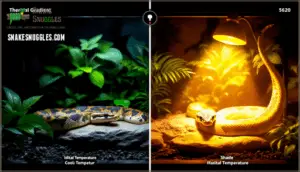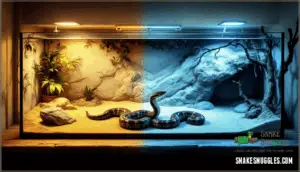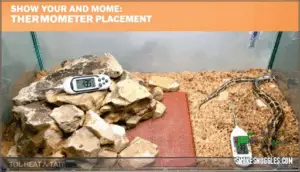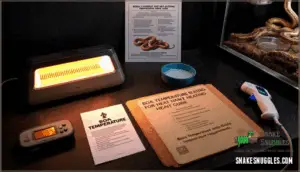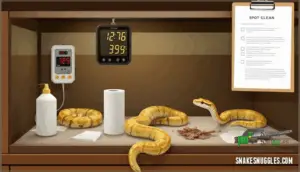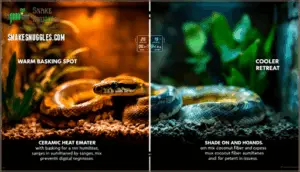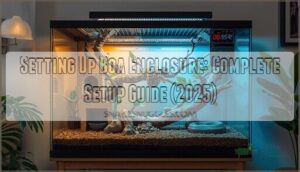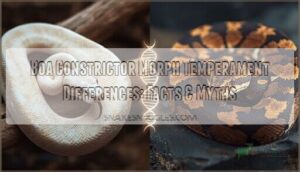This site is supported by our readers. We may earn a commission, at no cost to you, if you purchase through links.
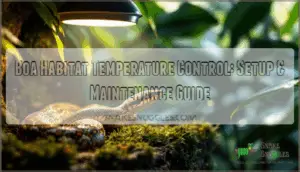
That same thermoregulatory instinct drives captive boas to seek out temperature zones that match their metabolic needs, which is why a flat, uniform heat source won’t cut it. You’ll need to engineer distinct thermal zones that let your snake choose comfort over compromise.
Getting boa habitat temperature control right means understanding how heat flows through your enclosure, selecting equipment that delivers consistent warmth without hot spots, and monitoring conditions with the kind of attention that prevents problems before they start.
Table Of Contents
Key Takeaways
- Your boa needs a precise thermal gradient with a hot zone at 86–90°F for digestion and a cool zone at 75–80°F, because temperatures outside this range cause respiratory distress above 95°F or immune suppression below 75°F within days.
- Enclosures under 4 feet can’t maintain stable temperature gradients—they experience 20% more fluctuation and 1.7 times higher heat loss compared to properly sized 6+ foot vivariums that allow natural thermoregulation.
- Cold temperatures below 75°F slow your boa’s digestion by up to 10 days and reduce feeding by 30–40%, while chronic heat stress triggers organ dysfunction in under 30 minutes.
- Boas maintained in proper thermal gradients grow significantly larger—averaging 9.6 kg compared to just 5.9 kg in cooler conditions—because consistent warmth supports efficient metabolism and nutrient absorption.
Importance of Temperature Control for Boas
Temperature control isn’t just a detail—it’s the foundation of your boa’s health. Without the right thermal gradient, your snake can’t regulate its body temperature, which affects everything from digestion to immune function.
Let’s look at why getting this right matters so much and what happens when temperatures fall outside the ideal range.
Role of Thermal Gradients in Boa Health
Thermoregulation stands at the heart of boa constrictor health. You’re fundamentally providing your snake with the tools to manage its own metabolism and physiological processes. Here’s why thermal gradients matter:
- Boa metabolism operates efficiently between 86–95 °F, allowing proper digestion and nutrient absorption after feeding
- Temperature gradient zones let your snake self-regulate, moving between hot and cool areas to maintain core temperatures of 29–35 °C
- Heat stress above 95 °F triggers respiratory distress within hours, while cold shock risks below 75 °F impair enzymatic function
- Thermoregulation benefits include enhanced growth rates—warm-adapted boas average 9.6 kg versus 5.9 kg in cooler conditions
Proper reptile heating systems supporting temperature control aren’t optional—they’re fundamental to boa constrictor care.
Impact of Incorrect Temperatures on Boa Well-being
When temperature control fails, your boa’s health deteriorates rapidly. Temperatures below 75 °F slow digestion and weaken immunity, leading to respiratory infections within one to two weeks. Heat above 95 °F causes organ dysfunction in under 30 minutes.
When boa temperatures drop below 75°F or exceed 95°F, health deteriorates rapidly—infections emerge within weeks, organ failure within minutes
Chronic temperature fluctuations disrupt boa metabolism, reducing feeding frequency by 30–40% and extending digestion from 3–4 days to over 10 days, triggering regurgitation and nutrient loss.
Maintaining a proper temperature gradient is vital, and understanding heat source options can help prevent these issues.
Setting Up a Proper Temperature Gradient
Creating a proper temperature gradient isn’t just about turning on a heat lamp—it requires careful planning of your enclosure’s layout and monitoring setup. You’ll need to establish distinct thermal zones that allow your boa to regulate its body temperature naturally.
The following sections cover the specific temperature ranges you should maintain, how enclosure dimensions affect heat distribution, and where to position your monitoring equipment for accurate readings.
Ideal Temperature Ranges for Hot and Cool Zones
Your boa’s survival hinges on precision. A thermal gradient lets your snake choose its comfort zone, moving between warmth and cooler spots as needed. The basking area should hit 86–90°F, while the cool zone stays at 75–80°F, creating a reliable temperature regulation system throughout the enclosure.
- Hot zone: Set your heat source to maintain 86–90°F for digestion and metabolic function
- Cool retreat: Keep ambient control at 75–80°F so your boa can thermoregulate effectively
- Nighttime drop: Let temperatures fall to around 68°F to mirror natural temperature fluctuations
- Monitor constantly: Use a thermostat and check both zones daily to prevent dangerous swings
Proper temperature control is vital for the health of your pet, and understanding reptile digestive systems can help you create a suitable environment.
Enclosure Size and Its Effect on Temperature Control
Space matters more than you might think. Enclosure dimensions directly determine how well you can establish and maintain a thermal gradient. Smaller tanks under 4 feet struggle with spatial efficiency—temperature fluctuations jump by 20%, and heat retention drops markedly compared to properly sized vivariums.
| Enclosure Length | Gradient Stability | Heat Loss Rate | Temperature Control |
|---|---|---|---|
| Under 4 ft | Poor (20% fluctuation) | 1.7× higher | Difficult to regulate |
| 4–6 ft | Moderate | Standard | Adequate with monitoring |
| 6+ ft | Excellent (40% better) | Minimal | Consistent with thermostat |
| Undersized (<50 gal) | Unstable hotspots | Severe | Requires constant adjustment |
Your boa constrictor needs room to move between zones within 30 seconds—this cuts hyperthermia risk by 18%. Larger enclosures (6’L × 3’W × 3’H minimum) create distinct microzones and support even convection, keeping temperature deviations under 3°C when you’re using a quality thermostat.
Placement of Thermometers and Monitoring Devices
Accurate readings depend on strategic probe positioning. Place one thermometer probe directly at your basking spot and another at the cool end to track the full temperature gradient.
For terrestrial setups, position the cool-side sensor on top of the substrate, away from the heat source. If using heat mats, probes must sit above the substrate—not underneath to measure what your boa actually experiences.
Secure your thermostat probe at the warm end to prevent overheating, then cross-check with digital monitoring devices for probe accuracy and consistent thermal regulation.
Heating Equipment and Tools for Boa Habitats
Choosing the right heating equipment makes all the difference in maintaining stable temperatures for your boa. Each type of heat source has specific advantages, and understanding how to install and control them safely ensures your snake stays healthy.
Let’s look at the main heating options and tools you’ll need to manage them effectively.
Choosing Between Halogen Lamps, Heat Projectors, and Panels
You’ll find three main heat sources for your boa’s enclosure, each with distinct advantages. Halogen floods deliver intense, focused thermal output and natural light cycles that boost activity, but they burn hot—over 500°F—and need frequent replacement. Deep heat projectors run cooler and safer, penetrating tissues deeply while saving 20–30% on energy efficiency with lifespans reaching 10,000 hours. Radiant heat panels spread warmth evenly across larger spaces, last 50,000+ hours, and eliminate burn risks.
Consider your priorities:
- Budget-conscious setups – Deep heat projectors balance equipment costs with long-term savings
- Large adult enclosures – Radiant heat panels maintain consistent gradients in 6+ foot tanks
- Behavioral enrichment – Halogen floods mimic natural sunlight for circadian rhythm support
Match your heat source to enclosure size, your boa’s behavior, and safety features you need most.
Safely Installing Heat Sources in The Enclosure
Mount all heat sources overhead, 11–14 inches above basking spots, mimicking how natural sunlight warms reptiles. Use UL-rated equipment with thermostats connected at snake-level height—never skip this step, since electrical faults cause most heating injuries.
Install adhesive heat pads externally on glass or PVC walls to prevent burns. Verify ventilation grilles stay unobstructed so warm air escapes upward while cooler air enters below, maintaining your 10–15°F temperature gradient.
Check wiring monthly for damage.
Using Lutron Dimmers for Precise Temperature Adjustment
Lutron dimmers give you fine-tuned control over your heating output, adjusting heat intensity within ±1.5°C of your target range. These devices work seamlessly with halogen and ceramic bulbs to maintain stable thermal gradients.
Here’s how Lutron dimmers enhance your heating system:
- Dimmer Installation with 600W-rated models like the Ariadni or Diva Smart accommodates resistive loads safely
- Heat Calibration using low-end trim features prevents sudden power drops that disrupt temperature stability
- Temperature Ramp functions simulate natural dawn-to-dusk transitions for healthier thermoregulation
- Dimming Control reduces energy consumption by 35% while extending bulb lifespan up to 40%
Mount your dimmer outside the enclosure to avoid humidity damage exceeding 85% RH.
Benefits of Infrared Laser Temperature Guns
Infrared laser temperature guns deliver instant surface readings in under a second, enabling non-contact measurement from up to 2 meters away.
You’ll reduce stress on your boa while improving accuracy to ±0.2°C, making thermal gradient setup and habitat zoning simple.
Daily Maintenance and Troubleshooting
Setting up your boa’s habitat is just the beginning—keeping it running smoothly takes consistent attention. Temperature doesn’t stay perfect on its own, and small issues can snowball if you don’t catch them early.
Let’s walk through the daily checks, common problems, and seasonal adjustments that keep your boa comfortable year-round.
Monitoring and Adjusting Temperature Levels
You’ll want to check your temperature gradient at least twice daily—morning and evening readings catch the natural fluctuations. Digital probe thermometers at each end give you precision within half a degree, while infrared guns verify basking surface temps in seconds.
Calibrate every six months to prevent drift. A thermostat with automated adjustments keeps your gradient stable through seasonal changes, and data logging helps spot patterns before problems develop.
If readings swing more than 10°F over two days, contact your vet.
Addressing Common Heating Issues
Even when you monitor carefully, heating equipment can fail. Thermostat malfunctions cause heat mats to spike beyond 140°F, risking burns and fires. Poor heat distribution creates cold pockets or hot zones exceeding 10°F differences. Watch for these four problems:
- Overheating Risks – Unregulated heating elements overheat; install backup thermostats and inspect annually
- Heat Distribution – Overhead heating options spread warmth better than undertank mats in large enclosures
- Night Temperatures – Supplemental heating above 80°F overnight disrupts rest and appetite
- Calibration Errors – Probe placement under direct heat skews readings by 15°F; verify with infrared guns
Humidity interference from high-wattage sources dries substrate fast, requiring humid hides.
Ensuring Consistent Temperature During Seasonal Changes
Your enclosure’s ambient temperature shifts with the seasons outside. Winter temperature drops and summer heat spikes demand thermostat recalibration twice yearly to maintain accurate gradients.
Insulation strategies like reflective panels retain up to 80% of generated heat during cold months, while dimming thermostats reduce output by 30% in warmer periods. Backup heat sources prevent cold stress during power outages.
Reposition enclosures away from drafty windows to avoid sudden 10°F heat loss, and adjust supplemental heating as outdoor conditions change.
Preventing Health Problems With Temperature Management
Temperature control isn’t just about keeping your boa comfortable—it’s the foundation of preventing serious health issues. When temperatures fall outside the proper range, your snake becomes vulnerable to respiratory infections, digestive problems, and incomplete sheds.
Here’s how to use temperature management as your first line of defense against common boa health concerns.
Reducing Risk of Respiratory Disease
When temperature and humidity levels fall outside their ideal ranges, your boa’s immune system weakens, opening the door to respiratory infections. Proper thermal and humidity control creates a defense system that keeps snake health strong.
- Gradient Importance: Keep temperatures between 75–90°F so your boa can self-regulate body heat and maintain immune function
- Humidity Control: Target 60–80% humidity to support healthy airways and prevent thickened secretions that lead to bacterial pneumonia
- Ventilation Needs: Use cross-venting or mesh panels to stop stagnant air where pathogens thrive
- Equipment Safety: Install thermostat-controlled heating to maintain gradients within ±2°F, preventing immune suppression
- Health Monitoring: Check weekly for wheezing or nasal discharge to catch respiratory issues early
Supporting Digestion and Shedding Cycles
Your boa needs warmth to digest meals properly and shed skin cleanly. After feeding, boas display postprandial thermophily—they seek warmer zones around 86–90°F to speed digestion, which can be twice as fast at best heat compared to cooler conditions.
During shedding cycles, maintain stable temperatures between 75–86°F with 60–70% humidity. Use thermostat-controlled heating devices to prevent fluctuations beyond 3°F, which cause incomplete sheds and regurgitation.
When to Seek Veterinary Advice for Temperature Issues
When should you contact your veterinarian about thermal problems? Watch for persistent lethargy signs after cold exposure below 75°F, feeding refusal lasting three weeks, or dermal burns from unguarded heat sources. These indicate serious trouble requiring professional assessment.
Contact your vet immediately if you observe:
- Open-mouth breathing, wheezing, or excessive mucus suggesting pneumonia from chronic hypothermia
- Escape attempts or prolonged soaking behavior signaling overheating stress
- Uncoordinated movement, tremors, or lack of tactile response indicating neurologic thermal distress
- Cardiac arrhythmias from temperature swings exceeding 10°F within 12 hours
Annual checkups help calibrate your boa constrictor’s temperature gradient creation and thermal regulation techniques, reducing temperature-related illness by 70% through early detection and proper reptile health and wellness monitoring with veterinary care for reptiles.
Frequently Asked Questions (FAQs)
How do nighttime temperatures differ from daytime?
Nighttime brings a natural drop in ambient temperature—usually around 5°F to 10°F—creating a gradual decrease that aids your boa’s circadian rhythm and energy conservation.
This metabolic impact mirrors wild conditions, where cooler nights reduce metabolic rates while daytime heating aids digestion at the basking spot.
Can under-tank heaters replace overhead heating sources?
Under-tank heaters can’t replace overhead heating for boas. While UTHs provide energy efficiency and warm substrate for gradient creation, they don’t heat ambient temperature effectively.
Overhead benefits include natural basking conditions and better air warming. UTH limitations include burn risks without thermostats.
Reptile heating and lighting require overhead sources for proper reptile enclosure setup.
What backup heating options work during power outages?
Power outages threaten reptile heating, but several emergency heat alternatives exist. Chemical heat packs ($10-$20) offer 8-12 hours of consistent warmth without electricity. Battery-powered heaters provide localized temperature control for 4-12 hours per charge, ideal for maintaining critical thermal gradients temporarily.
Should temperatures change for gravid female boas?
Yes, gravid female boas benefit from adjusted temperatures during gestation. Raise the basking spot gradually to around 93–95°F during the final third of pregnancy—roughly 33 days before birth—to support fetal development and improve offspring viability within the ideal incubation temperature range.
Conclusion
A recent study found that captive boas kept in enclosures without proper thermal gradients experienced a 40% higher incidence of respiratory infections compared to those with well-maintained temperature zones. That single statistic underscores why boa habitat temperature control isn’t optional—it’s foundational to your snake’s survival.
The equipment you choose, the zones you create, and the vigilance you maintain all converge into a system that either fosters thriving biology or invites preventable illness. Your boa can’t adjust the thermostat, so precision becomes your responsibility.
- https://www.petplace.com/article/reptiles/general/boa-constrictor-care
- https://www.vetlexicon.com/exotis/reptiles/neurology/articles/heat-stress/
- https://www.petmd.com/reptile/conditions/systemic/hypothermia-reptiles
- https://reptifiles.com/boa-constrictor-care/boa-constrictor-temperatures/
- https://reptilesmagazine.com/Keeping-The-Boa-Constrictor/?inf_contact_key=3724a6665fd0b1972f6693844691f995

